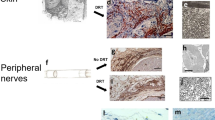Abstract
Induced organ regeneration is de novo synthesis of a physiological, or nearly physiological, organ at the same anatomical site as the organ that is being replaced. Regeneration of skin, peripheral nerves and the conjunctiva, described in this chapter, have been accomplished using biologically active scaffolds (regeneration templates) seeded with epithelial cells; devices for regeneration of the first two organs are in clinical use. There is substantial empirical evidence that templates induce regeneration by blocking contraction, the major mechanism for closure of severe wounds in adults. Templates appear to function by interfering with normal myofibroblast function well as by acting as temporary configurational guides for synthesis of new stroma that resembles that of the organ under replacement. The combined evidence supports a theory which predicts that selective blocking of the adult healing response uncovers the latent fetal response to injury and leads to organ regeneration. An independent theory suggests that loss of regenerative potential during the mammalian fetal-adult transition is associated with simultaneous acquisition of individual immunocompetence.

Preview
Unable to display preview. Download preview PDF.
Similar content being viewed by others
Author information
Authors and Affiliations
Corresponding author
Editor information
Rights and permissions
About this chapter
Cite this chapter
Yannas, I.V. Facts and Theories of Induced Organ Regeneration. In: Yannas, I.V. (eds) Regenerative Medicine I. Advances in Biochemical Engineering, vol 93. Springer, Berlin, Heidelberg. https://doi.org/10.1007/b99965
Download citation
DOI: https://doi.org/10.1007/b99965
Published:
Publisher Name: Springer, Berlin, Heidelberg
Print ISBN: 978-3-540-22871-4
Online ISBN: 978-3-540-31448-6
eBook Packages: Chemistry and Materials ScienceChemistry and Material Science (R0)




